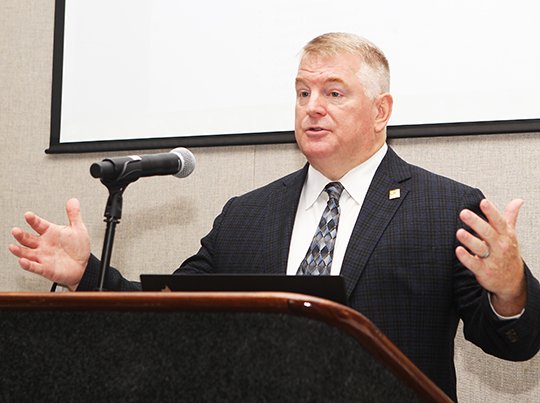The location of three points along the proposed 65-mile, multiuse trail linking Hot Springs and Little Rock are fixed, but points in between are fluid.
The engineering firm contracted by Garland, Pulaski and Saline counties for preliminary design work met with elected officials Wednesday at the Hot Springs Convention Center to hear their thoughts on where the Garland County leg of the Southwest Trail should go. A meeting soliciting input from the public will be held later this year.
The three counties shared the cost of the 20-percent match required for the $2.6 million Federal Lands Access Program grant they were awarded last year to fund 65 percent of the design work. They've applied for a Federal Highway Administration Transportation Alternative Program grant to fund the balance.
Wallace Smith, Garver LLC's vice president and director of federal services, told officials the FLAP grant was awarded with the understanding the trail would connect Hot Springs National Park to the Little Rock Central High School National Historic Site.
"That gave us the best path forward for success," Smith said. "We can connect two federal parks. That made our FLAP grant very appealing."
In between, the trail will cross the Old River Bridge spanning the Saline River. Smith said Saline County officials are trying to find funding to rehabilitate the bridge.
"Those are really the three anchor points," he said. "The trail will connect to those three. Outside of that, we're only in the conceptual stages."
Potential routes presented Wednesday showed the trail paralleling Spring Street, or Highway 88, after crossing East Grand Avenue at Convention Boulevard. East of Crossgate Church, the route diverges into two alternatives. One continues along Spring, going through Lonsdale, until the Saline County line. The other branches north toward Highway 70 east in the general direction of a railroad right of way.
State Sen. Alan Clark, R-District 13, of Lonsdale, said the northerly option traverses landscapes that will appeal more to bike riders and hikers than the Spring Street alternative.
"As far as aesthetic use of the trail, I would love for people to be able to come through and see how beautiful that is," he said. "You take it to (Highway 88) and put it over there with the traffic coming by, I have very little interest."
Both options converge east of Lonsdale, near the intersection of highways 88 and 70 east. Smith said the options will be better defined when the environmental assessment that's underway concludes next year.
"The Southwest Trail is not going to be constructed next year," Smith said. "We'll be finishing the EA next year. Once we finish the EA, we'll start getting serious and go right into design, topographic surveys and almost have the funds available to take design to 100 percent.
"Then it would be a matter of procuring what we estimate to be probably close to $40 million to build the Southwest Trail. There's a lot of potential different places where maybe some of that money might come."
Smith said after the environmental assessment identifies a preferred route, the onus will shift to counties and municipalities to acquire part of the 200 acres of right of way needed to forge the trail. Pulaski County has already purchased right of way along a rail line where the preliminary route crosses roughly 6 miles of the unincorporated part of the county.
Smith said while the Garland County stretch of the Highway 70 east expansion doesn't have enough right of way to accommodate the 10- to 12-foot trail, the right of way east of the county line is wide enough to take the trail as far east as Interstate 30.
Smith said wholesale condemnations may not be needed, as the trail could use parts of existing rail and street rights of way.
He said he expects the project to gain momentum when counties and municipalities along the trail are assured each other are committed to its completion.
"We've found on big projects like this, once the ball starts rolling people get excited," he said. "What we generally find with public officials is that no one wants to be the person who builds a trail to nowhere."
Buy-in from local governments can attract private-sector funding, he said, such as grants from the Walton Family Foundation. The nonprofit gifted Hot Springs with more than $600,000 last year to build 16 miles of bike trails in the city's Northwoods Urban Forest Park.
Local on 07/12/2018